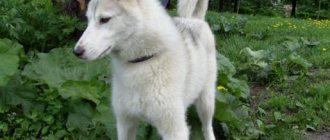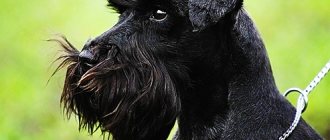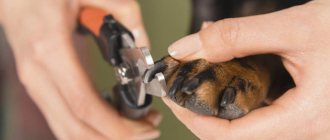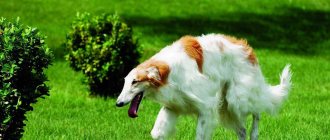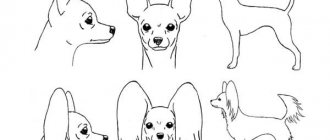Labrador - a miracle with a motor
Labrador is a breed that is suitable for almost anyone. The only exception, probably, are pensioners, as well as people who do not lead or do not want to lead an active lifestyle. Since this dog needs good physical activity and long walks. In addition, she, of course, needs joint games with the owner.
What is the nature of a Labrador? This is a dog with a strong, dense, muscular build. Her chest and back are wide. The back is level, the loin is strong and short. The head is wide without fleshy cheekbones. The jaws are of medium length, quite powerful, but soft. The eyes are medium in size, brown or hazel in color. Labradors' ears are medium-sized, drooping, not heavy, and set quite far back. The front legs are straight and bony. The hindquarters are well developed and there is no slope towards the tail. There are different colors: fawn, chocolate and black.
The height at the withers is 57 cm (on average), and the weight ranges from 25 to 40 kg.
Labrador behavior
Now let's talk about the character of such a dog and how a Labrador behaves in various conditions. Reviews about this dog are sometimes contradictory. Some say that a real angel has settled in their house, while others say that some kind of monster has appeared in their apartment and destroys everything in its path.
Every opinion is true, since the Labrador is a breed of very cheerful and playful dogs. They will find something to have fun even where, at first glance, there are no toys. To avoid problems with chewed things, you need to pick up a sufficient number of things for your pet to enjoy. Then, as a rule, no problems arise.
Character of Labradors
In general, Labradors are very good dogs, they are loyal, affectionate, and kind. These dogs make gentle nannies for children. Dogs understand their owners perfectly, one might say, perfectly. They sense the mood of their owner well. If he feels bad, the Labrador will come and lie down next to him, burying his muzzle in his knee. When the owner is busy, the dog will not disturb him.
Another big plus is the high level of intelligence of representatives of this breed. They learn well and quickly remember commands. In addition, they can take part in various sports competitions, such as agility.
Such a dog finds a common language with all representatives of the fauna. Labrador is even friends with cats. Reviews from owners confirm this phenomenon. In many families, Labrador cats and puppies get along well with their mother. By the way, purrs often take care of small dogs.
Retriever
We’ll probably start describing the breed with what its representative looks like. This is a dog with a harmonious, strong physique. Her limbs are muscular and her paws are round. The head is proportional to the body. The transition from the muzzle to the forehead is quite well defined, the parietal part is wide. Nose is black. The widely spaced eyes of this representative of the breed are dark brown in color, and the edges of the eyelids are dark. The ears are small, hanging, set approximately at eye level. The retriever has a wide chest, a fairly long and muscular neck.
The tail is straight, long, and never curls. The coat is wavy or straight, there is a thick undercoat that does not allow water to pass through. There are different colors (from any golden to cream). There are retrievers that have a white spot on their chest. The height at the withers of a representative of the breed is on average 55 cm. The weight of one such dog ranges from 26 to 41 kilograms.
Behavior and character of a handsome long-haired cat
The retriever is a hardy, fairly energetic dog. She has good instincts and excellent memory. A retriever dog exhibits its qualities both on land and in water, where it can search for (killed) game. Anyone who goes hunting with a dog believes that his best assistant is a retriever. Reviews of similar joint activities are confirmation. Indeed, they were originally bred to work in hunting. Now these dogs have successfully mastered many other specialties. Retrievers work at customs and participate in many rescue operations.
Representatives of the breed are good swimmers. They are also great with children. These dogs are highly trainable, but retriever training should take place in a calm atmosphere, without screaming or nervousness. These dogs catch everything on the fly. There is no need to raise your tone or use any serious punishment.
By nature, dogs are smart, affectionate, playful, kind and calm. They rarely bark, so they are not suitable for guard duty. Retrievers are not prone to dominance; they get along well with children. In many countries, these beauties are used as therapy dogs that brighten the lives of children with mental disorders, as well as those who live in shelters.
Retrievers make excellent therapy dogs due to their unique sensitivity and optimistic, gentle nature. If there are small children or elderly people in the family, then the golden retriever will become a friend and companion for them.
Such dogs are very delicate, they are not aggressive towards people (this behavior is not typical for them).
Who is better?
It cannot be said that some dogs are better and some are worse. Every breed, including Labradors and Golden Retrievers, has its own characteristics. Everyone chooses for themselves such a four-legged friend, communication with whom will be a joy for both the owner and the pet.
Labrador is a lively dog , and this must be taken into account immediately. Monotonous and calm walks do not suit him. Such a dog requires constant active action. He needs an owner with the same cheerful attitude and restless character, then they will live in complete idyll.
If jogging around the park with a dog is not part of your plans, but you want to see a calm and balanced dog , then it is better to give preference to a golden retriever . With it there is no need to constantly come up with new fun games. The dog understands the emotional state of its owner well and gets along well with people of all ages.
What are the differences and similarities between the breeds?
We figured out what Labrador and Retriever dogs are. What is the difference between these breeds? It is this topic that we will now discuss in detail.
These two breeds are very popular; due to their similarities, they are sometimes confused. The international names of these species also have similarities: Labrador Retriever and Golden Retriever. But besides this, there is much more in common.
I would like to say that there are also many differences between these breeds. Let's discuss them. This topic will be of interest especially to those who want a Labrador or retriever puppy in their home.
Both of these hunting breeds belong, according to the FCI classification, to Group 8, Section 1 – Retrievers. Initially, representatives of both species were intended for retrieving and searching for downed game.
Differences in origin
Labradors and goldens belong to the same group of retrievers, but they are two completely different breeds. The beginning of the differences between them lies in their origin. The breeds were developed in different parts of the world.
- Labrador comes from the island of Newfoundland. One of the earlier names of the breed is Lesser Newfoundland or St. John's Newfoundland. Indian dogs are considered his ancestors. Labradors lived surrounded by fishermen, whom they served faithfully. The dogs pulled fishing nets and took the shot prey out of the water . For their labor merits, the dogs were nicknamed hard workers.
- The Golden Retriever has a more aristocratic origin . The breed was developed by the English Lord Tweedmouth. It took many years to achieve the desired result. Goldens not only took an active part in hunting, but also decorated palaces with their representative appearance. The breed quickly gained popularity.
Labrador and retriever: what is the difference between these beautiful dogs?
Despite the similarities, they are still different breeds. The main difference between the two types of dogs is their different “social” origins. Golden Retrievers were bred by the Scottish Lord Tweedmouth. This man devoted half his life to breeding this breed.
Labrador is a direct descendant of Indian dogs that lived in a fishing village on the island of Newfoundland. In the winter, these dogs pulled sledges, and in the summer, they pulled fishing nets. From Portuguese the word labrador is translated as “hard worker”, “worker”.
The Labrador has a simpler appearance and is more stocky. According to the standard, the first impression of such a dog is “strong build, compact dog...”, and the first impression of a retriever is “a harmonious dog.”
If we talk about behavior, the Labrador is emotional and straightforward, while the retriever is reserved, impressionable, and sometimes even touchy. Although all these character traits in the process of upbringing can change both for the worse and for the better. In this matter, everything depends on the individual owner.
Purpose of dogs
Retriever and Labrador differ not only in origin. Their special skills also speak volumes. For example, the Labrador is often called “the dog of the people.” This dog can do any kind of work (collecting caught fish, pulling a net or pulling a sled - an impossible task for such a worker still needs to be found).
As for the retriever, this type of dog is considered somewhat more sophisticated. He collects shot game. But his appearance alone indicates that the dog does not cope with physical labor very well. He is not as stocky as a Newfoundland dog with similar characteristics, and his range of physical abilities is therefore limited.
Similar article: Rules for raising and training a Labrador from the first days
Visible differences between representatives of breeds
Now let's look at the visible differences between the Labrador and Retriever breeds. What is the difference between them?
- Firstly, the color. When the lord developed the retriever breed, he preferred a color that was clearly visible against the background of dark peat bogs. Therefore, colors of all golden shades are acceptable for representatives. If you see a dog with a chocolate or black color, you know that this is a Labrador. Although there may be doubt - representatives of both breeds can have a fawn color.
- Secondly – wool. This is another distinctive feature. Labradors' fur is covered with a specific, easily tactile coating. Anyone who wants to get such a dog must understand that such a coating is not pleasant for everyone, it is “greasy”. The guard hair is not silky, thick, elastic. The length of the spine does not exceed five centimeters. Curly and wavy hairs are not acceptable for a Labrador. The retriever dog has a more decorative coat of golden (shiny) shades, often with a light wave. On the hips, tail, neck and back of the paws there are beautiful long feathers, usually a shade lighter than the base color.
- Thirdly, the Labrador has an “otter” tail (covered with strong, short hair, thickened at the base). The retriever has a feathered tail, which is decorated with the same dewlap as that of setters. When in high spirits, the Labrador carries a “cheerful” tail (it is at a right angle to the back). In a retriever, the line of the back is continued by the line of the tail (he sometimes only raises his tail up).
- Fourthly, this is the head. In Labradors it looks a little more massive than in retrievers. The first representatives were used for large prey, including hares (weighing an average of five kilograms). Retrievers were “sharpened” for feathered, lighter game.
Origins of similarities
According to the FCI classification, both breeds belong to Group 8, Section 1 – Retrievers. These are hunting dogs, originally intended for searching and retrieving downed game (from the English retrieve - “to re-find, retrieve lost, restore”). According to the descriptions of L.P. Sabaneev, hunting with a retriever looked like this: the pointer finds the game, lifts it on the wing and, having learned not to get shot, lies down. The hunter shoots. The retriever (he previously followed on the heels of the owner, without running ahead) goes on a search, brings prey and returns to his place, behind the hunter.
The retriever (now we are talking about both breeds) was not encouraged to strive for leadership - he should not get ahead, interfere with the pointer and compete with her. Animals that were balanced in character were selected - after all, on any hunt there are wounded animals that must first be caught and then delivered to the owner. For any dog, a very difficult task is not to succumb to the excitement and not run over the flailing wounded animal...
Labrador at work
It was important that the dog did not crush the trophy. Therefore, the so-called soft tooth was valued - powerful jaws, used, however, very carefully. This is a characteristic feature of the breed group. The absence of bloodthirstiness was cultivated in retrievers, and this played a role - the breed is unsuitable for protection. The retriever will not tear apart a stranger; on the contrary, he will be glad to meet you. These dogs get along with all family members and other pets. They are strong - they are able to repel even a wolf, and at the same time they are not conflicting.
It was necessary to bring prey from afar, as a rule, from the water or from the bushes. That is, the dog must have a dense build that allows it to push through thickets, a wide, deep mouth and a powerful neck in order to hold the game suspended for a long time. Retrievers are efficient and tireless - they are able to scurry from the shore to the pond and back for hours. They gravitate toward water and love to swim.
"Mass Swim" of Golden Retrievers
Many years of selection for the above characteristics have led to the fact that representatives of both breeds have acquired many common features not only in appearance, but also in character. Both of them are different in intelligence. They are characterized by excellent memory and intelligence, like most water dogs: after all, water is not a dog’s habitat, instincts do not always help...

